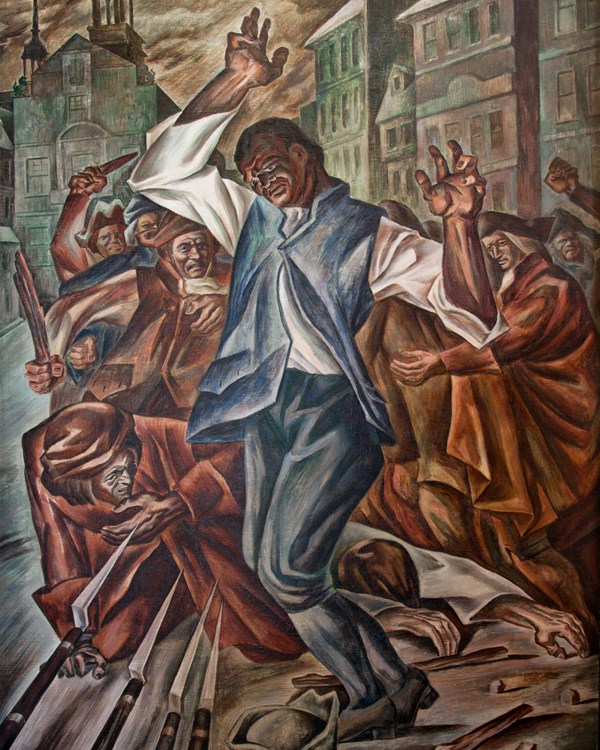Last updated: February 5, 2025
Person
Crispus Attucks

Library of Congress
Crispus Attucks, a sailor of mixed African and Indigenous ancestry, died in Boston on March 5, 1770 after British soldiers fired two musket balls into his chest.1 His death and that of four other men at the hands of the 29th Regiment became known as the Boston Massacre. Death instantly transformed Attucks from an anonymous sailor into a martyr for a burgeoning revolutionary cause.
The life of Crispus Attucks is far less documented than his death. Early coverage and investigations into the details of the Massacre refer to Attucks as Michael Johnson,2 a name he may have used as an intentional alias. After uncovering his actual name, newspapers published a few details about his life, notably his profession, a sailor; his birth in Framingham, Massachusetts; his current residence of New Providence in the Bahamas; and his ship's destination of North Carolina.3 His last name, "Attucks," is of Indigenous origin, deriving from the Natick word for "deer."4 Witness testimony during the Massacre trial interchangeably used "mulatto" or "Indian" to describe Attucks, indicating his mixed African and Indigenous birth.5
His first name reflects the trend in the colonial era of enslavers forcing an Ancient Roman name onto their enslaved people.6 Attucks shares the name "Crispus" with the son of Emperor Constantine.7 He also appears in a 1750 advertisement in the Boston Gazette. William Brown of Framingham placed an advertisement to call for the return of a twenty-seven year old escaped enslaved man named "Crispas," described as a six foot two inch "mulatto."8 Contemporary sources at the time of his death do not identify Attucks as enslaved or formerly enslaved. How and when he gained his freedom is unknown, but it is possible that Attucks used the name Michael Johnson to protect himself from a return to slavery.
On March 5, 1770, witnesses placed Attucks at the head of a group of sailors brandishing clubs and marching toward King Street. A crowd formed around a small group of British soldiers, hurling snowballs, ice balls, and insults at the men. Observers noted Attucks leaned his tall frame on his cordwood club.9 Amid the chaos, Private Montgomery and the rest of the soldiers fired into the crowd. Two musket balls ripped through Attucks chest, killing him instantly.10 In the following days, the people of Boston held a funeral procession for the victims of the massacre. Because Attucks and fellow victim and sailor James Caldwell had no family or home in Boston, their bodies lay in state at Faneuil Hall.11
Defending the soldiers in the subsequent trial, John Adams painted Attucks and the rest of those killed as aggressors to justify the killing. He played to the jury's prejudices about race and class, describing those in the crowd as "a motley rabble of saucy boys, Negroes, and mulattos, Irish teagues and outlandish jack tars."12 In other words, those in the crowd were young, lower-class, Black, Irish, or sailors from out of town. Adams' argument led to an acquittal for the Captain and all but two of the soldiers.
Town officials buried the victims of the Massacre in the Granary Burying Ground. Today, they share a headstone facing toward Tremont Street.
In the 1800s, abolitionists in Boston, led by William Cooper Nell, held up the death of Attucks as the first martyr of the American Revolution. Nell's seminal work, The Colored Patriots of the American Revolution, fought the erasure of Black people from the story of the American Revolution. Nell led this work with the story of Crispus Attucks, highlighting his death as the first in the cause for liberty.13 Though Black Bostonians have commemorated the anniversary of Attucks' death since at least the 1850s,14 it took until the early twentieth century when activists, including William Monroe Trotter, pushed the city of Boston to officially recognize March 5 as Crispus Attucks Day,15 a tradition which continues to the present day.
Learn More...
Revolutionary Spaces - Reflecting Attucks Virtual Exhibit
Footnotes
- "Boston March 12," Pennsylvania Gazette, March 22, 1770, 2.
- "Mortuary Notice," The Boston News-Letter, March 15, 1770.
- "Boston March 12" Pennsylvania Gazette, March 22, 1770, 2.
- James Hammond Trumbull, "Natick Dictionary" (United States: U.S. Government Printing Office, 1903), 243.
- William Weems, John Adams, Frederic Kidder, History of the Boston Massacre, March 5, 1770: Consisting of the Narrative of the Town, the Trial of the Soldiers: and a Historical Introduction, Containing Unpublished Documents of John Adams, and Explanatory Notes (United States: J. Munsell, 1870), 134.
- Classicisms in the Black Atlantic (United Kingdom: Oxford University Press, 2020), 14.
- David Woods, "On the Death of the Empress Fausta," in Greece and Rome 45 (1) (Cambridge University Press, 1998), 70–86, doi:10.1093/gr/45.1.70.
- "Advertisement," Boston Gazette, October 2, 1750, 2.
- Weems, Adams, Kidder, History of the Boston Massacre, 6.
- "To the Printers," Boston Gazette, December 31, 1770.
- Boston Post-Boy, March 12, 1770, 3.
- Weems, Adams, Kidder, History of the Boston Massacre, 255.
- William Cooper Nell, Harriet Beecher Stowe, The Colored Patriots of the American Revolution: With Sketches of Several Distinguished Colored Persons: to which is Added a Brief Survey of the Condition and Prospects of Colored Americans (United States: R.F. Wallcut, 1855), 14.
- "The Boston Massacre, March 5, 1770," The Liberator, March 12, 1858, 1.
- "Pay Tribute to Attucks on Anniversary of Massacre," The Boston Globe, March 5, 1928, 19.
